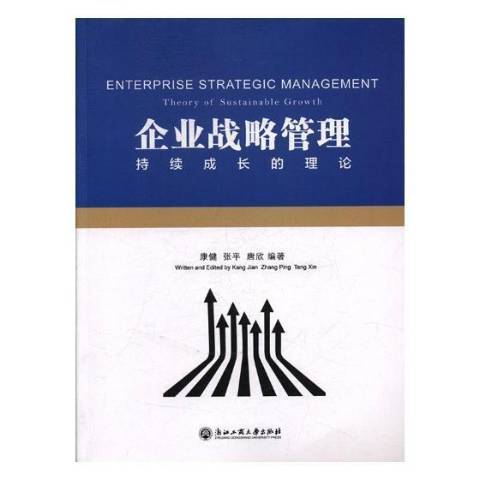《企業戰略管理:持續成長的理論》是2017年浙江工商大學出版社出版的圖書。
基本介紹
- 中文名:企業戰略管理:持續成長的理論
- 作者:康健、張閏、唐欣
- 出版社:浙江工商大學出版社
- 出版時間:2017年
- 開本:16 開
- 裝幀:平裝
- ISBN:9787517823353

《企業戰略管理:持續成長的理論》是2017年浙江工商大學出版社出版的圖書。
《企業戰略管理:持續成長的理論》是2017年浙江工商大學出版社出版的圖書。內容簡介 《企業戰略管理:持續成長的理論》闡述了企業戰略管理的基本理論和概念,說明了企業使命制訂、願景闡述、內外部分析、戰略制訂、戰略執行、戰略控制等模組的內容,《企業戰略管理:持續成長的理論》主要使用英文進行內容闡述,重要的關鍵點...
企業戰略管理是從全局和長遠的觀點研究企業在競爭環境下,生存與發展的重大問題,是現代企業高層領導人最主要的職能,在現代企業管理中處於核心地位,是決定企業經營成敗的關鍵。企業戰略管理是一個層次化的體系,理論認為公司戰略分為三個層次:公司戰略(Corporate Strategy)、經營戰略、職能戰略(Function Strategy),...
約翰霍普金斯大學(Johns Hopkins University)教授安蒂思·潘羅斯(Penrose)出版於1959年的《企業增長理論》一書,是一部繼承了熊彼特傳統,從經濟學角度通過研究企業內部動態活動來分析企業行為的經濟學著作。潘羅斯認為,企業是一個管理組織,同時也是人力、物力資源的集合,企業內部的資源是企業成長的動力。潘羅斯通過建構...
戰略 企業可持續發展戰略非常繁雜,然而眾多理論都是從企業內部某一方面的特性來論述的。根據國內外研究者和實際工作者的總結,可以把企業併購區分為以下幾種類型。企業可持續發展戰略主要有創新可持續發展戰略、文化可持續發展戰略、制度可持續發展戰略、核心競爭力可持續發展戰略、要素可持續發展戰略。(1)創新可持續...
《企業戰略管理》是2015年清華大學出版社出版的圖書,作者是馮志強。內容簡介 本書從高職高專學生的學習實際出發,以企業戰略管理的實際工作過程為依據,構建了系統的知識體系,全書共包括十章內容,理論與實踐相結合,吸納了企業戰略管理的最新研究成果。本書在具體知識點的介紹中引用了大量典型案例,進行深入淺出的分析...
最早提出企業成長理論的學者是一位女經濟學家伊迪絲·彭羅斯,其代表作就是《企業成長理論》。有別於經濟學家關注企業成長的經濟型因素和制度性因素,管理學家們則更偏向於從企業內部管理的角度來研究企業的成長性,如戰略理論、經營成長理論、管理與技術成長理論等。中國的企業成長性研究時間不到二十年,早期的研究者...
《企業戰略管理》是2002年6月1日清華大學出版社、北京交通大學出版社出版的圖書,作者是赫連志巍、張敬偉、王立國。內容簡介 作者曾給管理專業本科生、碩士研究生講授過多輪“企業戰略管理”課,在教學過程中運用了大量的國內外戰略管理資料,積累了豐富的教學經驗。作者的寫作態度是嚴肅認真的,堅持理論聯繫實際,充分...
《企業戰略管理》是2014年清華大學出版社出版的圖書,作者是鄧新明、李劍峰、侯俊東、崔楠、吳錦峰。內容簡介 本書共分為14章,內容包括:導論;戰略分析(包括內部與外部視角);超強競爭環境與動態競爭;公司層戰略;經營層戰略;戰略態勢與戰略轉型;企業併購戰略;戰略聯盟;國際化戰略;企業創新戰略:從紅海到藍海;...
本書按戰略管理過程組織內容,實現了教材結構與戰略管理過程的一致,從而為讀者提供了一個清晰的企業戰略管理的全貌。在各章內容安排上,包括學習要點及目標、關鍵概念、引導案例、主要教學內容、本章小結、複習與思考和案例分析等7個部分。本書理論聯繫實際,體系結構嚴謹,通俗易懂,實用性強,並配有一定數量的專欄、...
本書既可作為高等院校相關專業學生的教材,也可作為企業界的經營者和管理者的參考資料。目錄 第一篇企業戰略管理導論 第一章企業戰略 第一節企業戰略的含義 第二節企業戰略的基本性質 第三節企業戰略的特徵 第四節企業戰略的構成要素 第五節企業戰略的層次 第六節戰略管理的內涵及過程 第七節戰略管理的理論演進 ...
《企業戰略管理》是2012年東南大學出版社出版的圖書。內容簡介 全書共分五篇,共十三章,內容涵蓋了企業戰略管理基本概念、理論、願景與使命、內外部環境分析、公司層戰略、競爭戰略、職能戰略、國際化戰略、戰略實施、戰略控制、戰略變革及戰略管理前沿等內容。為了幫助讀者更好地學習企業戰略管理課程,本書不僅架構了...
為更好地把握戰略管理的發展趨勢,必須首先對戰略管理理論的發展歷程進行梳理,以便把握其演進的脈絡和規律。演變 企業戰略理論研究時間並不長,自20世紀60年代到現在僅有半個世紀。從時間跨度來看,主要經歷了以下幾個發展階段:70年代 20世紀60年代初美國著名管理學家錢德勒《戰略與結構:工業企業史的考證》一書的...
企業戰略管理學同企業管理學的其它分支相比,具有下列特徵:(1)綜合性強,它吸收了市場學、財務管理學、組織行為學和公司文化等學科的理論。此外,其研究對象又涉及到企業的生產、組織、財務等所有領域,是企業所有領域的有機綜合。(2)理論同實際聯繫緊密。一方面,其理論直接來源於大公司的經驗;另一方面,其理論的...
重視戰略的實施 日常的經營與計畫控制 重視戰略的評價與更新 理論歷史 早期言論 安索夫最初在其1976年出版的《從戰略規劃到戰略管理》一書中提出了“企業戰略管理”。他認為:企業的戰略管理是指將企業的日常業務決策同長期計畫決策相結合而形成的一系列經營管理業務。斯坦納在他1982年出版的《企業政策與戰略》一書中...
該課程以案例分析與課堂討論為主,強調學生在思考、參與和分析問題的過程中學習。幫助學生通過本課程學習,掌握企業戰略管理理論發展的主要脈絡、戰略管理分析的主要方法和工具,具備基本的戰略管理分析能力。所獲榮譽 2019年1月8日,該課被中華人民共和國教育部評為“2018年國家精品線上開放課程”。教師簡介 揭筱紋,...
本書可作為高等院校經濟管理專業本科生教材,還可供研究生(包括MBA學生)使用,也可供在職人員攻讀碩士學位使用。同時,本書對工商企業界的經營者和管理者也具有參考價值。內容簡介 本書是套用型本科經管類“十三五”規劃教材之一,在吸取國內外企業戰略管理理論及前沿學科理論的基礎上,結合我國的具體國情,全面而系統...
”見吳曉波:大敗局,浙江人民出版社,2001年,“從中國企業的’‘失敗基因’談起”(代序)第1~2頁。本頁面的文字允許在CC-BY-SA 3.0協定和GNU自由文檔許可證下修改和再使用。企業成長階段生命周期理論 企業成長階段的劃分:企業的生命周期,是指企業誕生、成長、壯大、衰退,直至死亡的過程。根據對企業成長 過...
《企業戰略管理》是2015年南開大學出版社出版的圖書,作者是李國英、王丹丹、崔玉蕾。內容簡介 《企業戰略管理》對企業戰略管理的基本理論做了系統的闡述,具體介紹了企業戰略管理的基本知識,企業環境分析,企業戰略選擇,企業戰略制定、實施和控制。《企業戰略管理》的大特點不僅體現在其清晰的脈絡上,即企業戰略的概念...
本書針對企業戰路管理的需要和企業經營管理人員的特點,用通俗易懂的語言和生動的案例,系統介紹了企業戰略的概論、制定、實施、評估、控制和變革等基本理論和方法,同時融入了《孫子兵法》、《三國演義》等經典軍事戰例,是一本很有特色的企業戰略管理教材,很受企業管理人員和管理院校師生歡迎。2002年2月第1版第1次...
《企業戰略管理》理論保留經典又體現發展,方法成體系且可操作,案例具有代表性。目錄 第一篇 戰略管理總論 第一章 企業戰略管理概述 3 一、什麼是戰略 3 二、什麼是企業戰略 5 三、企業戰略管理 21 第二章 企業願景、使命和戰略目標 32 一、企業願景 32 二、企業使命 34 三、企業戰略目標 46 第二篇 戰略...
第二章戰略管理理論的演進與發展 開篇寓言 第一節 戰略管理的演進 第二節 戰略管理的發展 本章小結 思考題 參考文獻 第二篇戰略分析 第三章 企業的環境分析 開篇案例 第一節 企業環境的構成及特徵 第二節 巨觀環境分析 第三節產業環境分析 第四節競爭對手分析 第五節戰略集團 第六節 企業的內部環境分析 本...
本教材從中國企業所嵌入的情境特徵出發,以環境動態化為主要視角,系統整合全球視野與國內情境、企業戰略管理的靜態模式與動態模式、企業戰略思維的產業組織模式與資源基礎模式,全面介紹了國內外學者在企業戰略管理基本理論、工具和方法上的主要成果。本教材使用了大量能夠及時反映中國企業戰略實踐的典型案例和實例,這將有...
壯年期並非生命周期的頂點,企業應該通過自己正確的決策和不斷的創新變革,使他持續增長。但如果失去再創業的勁頭,就會喪失活力,停止增長,走向官僚化和衰退。企業生命周期的理論和方法,把企業看成一個機體,而不僅僅是一個組織,從把握全程到注重階段提出動態管理的思想,對於思考企業的戰略管理,提供了一個新的視角...
《企業戰略管理》是2010年科學出版社出版的圖書,作者是胡恩華。內容簡介 本書汲取中外人類在社會經濟活動中所積累的戰略管理思想和戰略管理理論的精華,闡釋了企業戰略管理的戰略分析、戰略選擇和戰略實施的基本理論與方法。圖書目錄 前言 第1章 企業戰略管理概述 第2章 企業願景、使命與目標 第3章 企業外部環境分析...
《企業戰略管理》是2000年3月1日中國鐵道出版社出版的圖書,作者是北方交通大學。內容簡介 本書是“高等學校工商管理系列教材”之一。它力求反映企業戰略管理的最新理論,並結合當代企業戰備管理實踐的需要,增加了企業技術創新戰略,小企業經營戰略等內容。本書貫徹案例,以便學習參考和課堂研討。本書主要適用於工商管理...
